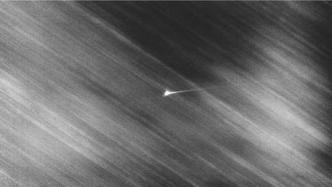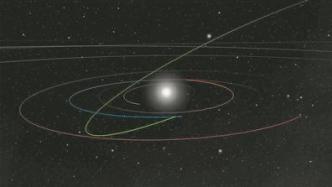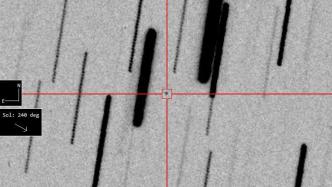

An image one month after the asteroid was struck by DART. Asteroid Didymos is in the center of the image. Credit: Mount John Observatory, University of Canterbury, New Zealand
Last September, NASA's Double Asteroid Redirection Test (DART) probe crashed into an asteroid, deliberately altering its trajectory through space in the first planetary defense test. Now, scientists have deconstructed the collision and its aftermath, and learned just how successful the cosmic crash was.
On March 1, Nature published five studies describing the final moments of the DART impact and how it affected the asteroid. This result suggests that DART probes like this one could be a viable way to protect Earth from asteroid strikes.
Golf cart-sized DART collided with pyramid-sized asteroid Dimorphos, causing the latter to narrow its orbit around another asteroid — now 33 times faster than it was before the impact, according to research led by Northern Arizona University. minute. This means that if a hazardous asteroid is detected heading toward Earth, hitting it could deflect it away from Earth.
The Johns Hopkins-led study combined the probe's orbital data with photos of the asteroid's surface before it struck and found that as DART was hurtling toward Dimorphos at 6 km/s, it was DART that was hit first A solar panel on the ground, which hit a 6.5-meter-wide boulder. Microseconds later, the main body of the spacecraft collided with the rocky surface next to the boulder, smashing the $330 million DART into pieces.
The impact ejected at least 1 million kilograms of rock from the 4.3 billion-kilo Dimorphos. The debris formed a tail that stretched tens of thousands of kilometers behind the asteroid. Over a period of several weeks, various telescopes observed the tail moving and changing in the Sun's rays. Among them, the Hubble Space Telescope even found a second tail, but it disappeared 18 days after impact.
Dimorphos is 151 meters wide and orbits the larger asteroid Didymos. NASA's goal is to alter Dimorphos' orbit, allowing astronomers to spot changes in Dimorphos' brightness by monitoring its brightness with ground-based telescopes. No matter now or in the future, these two asteroids will not pose a threat to the earth.
Images taken during DART's close approach to Dimorphos show the asteroid looking like an egg covered in boulders. It appears to be a loose pile of rubble, barely held together by gravity -- and when DART hits the asteroid, its surface shatters violently.
Carolyn Ernst, a planetary scientist at the Johns Hopkins University Applied Physics Laboratory, said the discovery of more details could help researchers understand why the impact was so successful in deflecting the asteroid.
One theory about the change in Dimorphos' orbit is that DART hit about 25 meters from the asteroid's center to maximize its impact. Another theory is that a large amount of rubble flew out when the asteroid hit, and the resulting recoil caused the asteroid to further deviate from its previous orbit. The Johns Hopkins researchers estimate that this ejection of rubble means that Dimorphos has almost four times the added momentum of DART.
The researchers believe that while NASA has only demonstrated the technology on one asteroid, the effects could be used to eliminate future hazards posed by asteroids.
The researchers are continuing to study DART's data to learn more about the physics, chemistry and geology of Dimorphos and Didymos. They observed the asteroids with telescopes before, during and after the impact and found that after the DART impact, the asteroid appeared to suddenly become redder.
NASA infrared telescopes also found that the asteroid then began to turn blue. Cristina Thomas, a planetary scientist at Northern Arizona University, explained that the impact penetrated the asteroid's weathered interior, exposing parts of its internal structure and giving the asteroid a blue color for a few hours after the impact.
Scientists are expected to take a closer look at the aftermath of the impact in late 2026, when the European Space Agency's Hera spacecraft arrives at Dimorphos. Researchers are curious to know what kind of crater the DART impact left behind. Meanwhile, detailed science observations will continue for several weeks until Didymos and Dimorphos are too far from Earth to be seen by telescopes. (Original title "Nature publishes 5 papers in a row: spaceship impact: Asteroid "lost meat" of 1 million kilograms")
Related paper information:
https://doi.org/10.1038/s41586-023-05805-2
https://doi.org/10.1038/s41586-023-05810-5
https://doi.org/10.1038/s41586-023-05811-4
https://doi.org/10.1038/s41586-023-05878-z
https://doi.org/10.1038/s41586-023-05852-9


